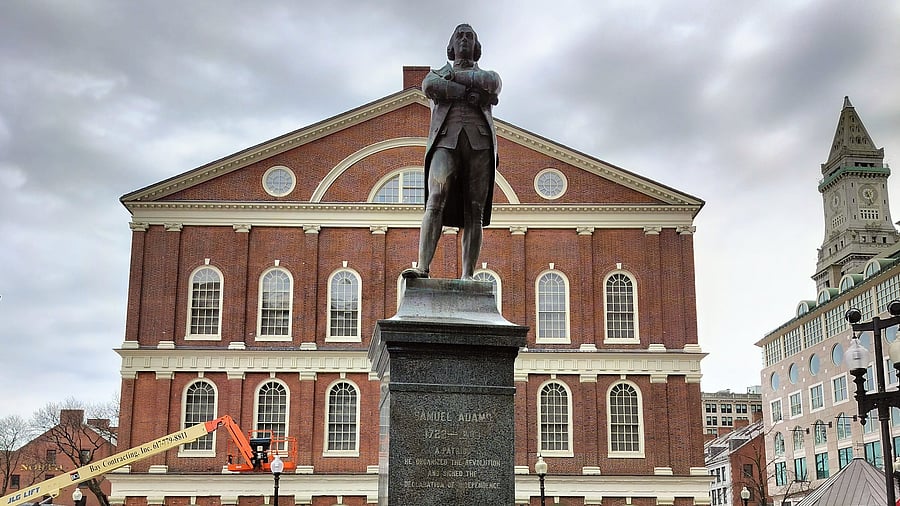
Faneuil Hall served as a gathering space for successive generations to discuss and debate the meaning and legacy of American liberty.
PHOTO BY AUTHOR
Only three hours to explore Boston! Events beyond my control meant I had extremely limited time to catch a glimpse of this city. Like me, if you have to choose between the multiple tourist activities (Harvard University campus walking tour, various museums, etc.), it’s the Freedom Trail that you should opt for. Boston is the city where the Boston Tea Party took place in 1773 — the event that ultimately led to the war against the British and the eventual birth of the nation.
The Freedom Trail begins at the Boston Common, which, like everything else in Boston, is historic, as it is the oldest public park in America, having been established in 1634. There are 16 places of interest along the trail, which is two and a half miles long. For the convenience of solitary tourists like me, the trail is easy to find and follow as it starts right from the tourist office in the Boston Common and is marked all through by a linear row of red and blue bricks. In addition, the actual sites are denoted by large tiles with brass markers embedded in the ground.
The first building is the Massachusetts State House, which stands out because of its beautiful gold dome. The Granary Burying Ground (so-called because it was previously next to a granary) is next, and it is here that many Bostonian heroes of the Revolution are buried. Key among them are John Hancock (whose name was signed with a flourish on the Declaration of Independence in 1776, leading to the words John Hancock as a synonym for signature) as well as Paul Revere and Samuel Adams. A memorial to the Franklin family exists in the centre. While Benjamin Franklin doesn’t rest here, we see references to him (and Sam Adams and Paul Revere) repeatedly through the trail. The Old South Meeting House, earlier the largest building in colonial Boston, is of importance because this was where the Boston Tea Party was plotted.
Some modernity creeps into the trail when you come across the Faneuil Hall, once the meeting place of Bostonians, but now a shopping centre. Faneuil Hall is also next to Quincy Market, a food court of repute. Adjacent to Faneuil Hall is another new structure — the Samuel Adams brewery and taproom. Because, you see, Samuel Adams was a patriot and brewmaster, besides being a signatory to the Declaration of Independence.
Paul Revere’s house — the oldest existing building in Old Boston — has been maintained for obvious reasons. After all, Paul Revere was the man who rode his horse at midnight on April 18, 1775, warning the people about the approaching British army. The North Church is the antepenultimate sight, but for me, the trip had to end at this point for want of time. The last two points on the trail are the Copp’s Hill burying ground and the Bunker Hill Monument (there’s always a next time). Something else to add for that next time is the USS Constitution, the world’s oldest commissioned warship afloat, affectionately called Old Ironsides because it withstood numerous attempts by the enemy to sink it.
I, however, compensated for this by noting other things. At the very beginning of the trail is a sculpture, The Embrace, that represents Rev Martin Luther King and his wife, Coretta King. The setting of this innovative sculpture is perfect because it does, after all, represent the beginning of another kind of freedom trail — one that Americans faced a couple of centuries later, that of the civil rights movement.
A marvellously creative — if slightly eerie — New England Holocaust Memorial is also, by chance, along the Freedom Trail. The memorial, erected in 1995, consists of a series of vertical glass towers — each with steam emanating from the perforated floors — clearly reflecting the deathly gas chambers that Nazi Germany had used, eight decades ago. A much more cheerful item to note along the trail is that many of the public houses along this Freedom Trail are amongst the oldest in America. In particular, the Bell-in-Hand (established 1795) states proudly that it is the oldest continuously run tavern in the country! The name reflects the fact that the owner, Jimmy Wilson, was the town crier (announced with a bell in hand) for 50 years. Adjacent to this pub of repute is the Green Dragon Tavern and the Union Oyster House, also rated for its historic importance for its roles as meeting and plotting places during the war.
A friend found the trail a little underwhelming: I could see what he meant, as many of the buildings have associated museums, but with separate entrance fees for each. But if time is an issue and if you seek a bird’s eye view of the early history of the American War of Independence and Boston’s role in it, this trail is worth every minute.